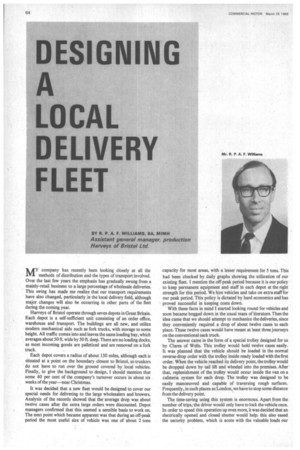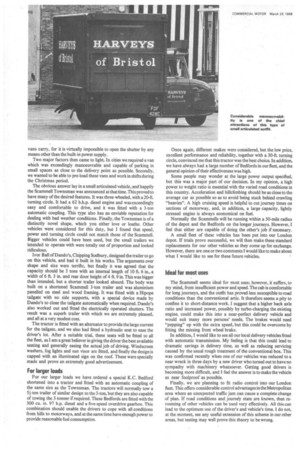DESIGNING LOCAL DELIVERY FLEET
Page 66

Page 68

If you've noticed an error in this article please click here to report it so we can fix it.
BY R. P. A. F. WILLIAMS, BA, MIMH
Assistant general manager, production fiarveys of Bristol Ltd.
MY company has recently been looking closely at all the methods of distribution and the types of transport involved. Over the last few years the emphasis has gradually swung from a mainly-retail business to a large percentage of wholesale deliveries. This swing has made me realize that our transport requirements have also changed, particularly in the local delivery field, although major changes will also be occurring in other parts of the fleet during the coming year.
Harveys of Bristol operate through seven depots in Great Britain. Each depot is a self-sufficient unit consisting of an order office, warehouse and transport. The buildings are all new, and utilize modern mechanical aids such as fork trucks, with storage to some height. All traffic comes into and leaves the same loading bay, which averages about 50 ft. wide by 50 ft. deep. There are no loading docks, as most incoming goods are palletized and are removed on a fork truck.
Each depot covers a radius of about 150 miles, although each is situated at a point on the boundary closest to Bristol, so trunkers do not have to run over the ground covered by local vehicles. Finally, to give the background to design, I should mention that some 40 per cent of the company's turnover occurs in about six weeks of the year—near Christmas.
It was decided that a new fleet would be designed to cover our special needs for delivering to the large wholesalers and brewers. Analysis of the records showed that the average drop was about twelve cases after the extra large orders were discounted. Depot managers confirmed that this seemed a sensible basis to work on. The next point which became apparent was that during an off-peak period the most useful size of vehicle was one of about 2 tons capacity for most areas, with a lesser requirement for 5 tons. This had been checked by daily graphs showing the utilization of our existing fleet. I mention the off-peak period because it is our policy to keep permanent equipment and staff in each depot at the right strength for this period. We hire vehicles and take on extra staff for our peak period. This policy is dictated by hard economics and has proved successful in keeping costs down.
With these facts in mind I started looking round for vehicles and soon became bogged down in the usual mass of literature. Then the idea came that we should attempt to mechanize the deliveries, since they conveniently required a drop of about twelve cases to each place. These twelve cases would have meant at least three journeys on the conventional sack truck.
The answer came in the form of a special trolley designed for us by Clares of Wells. This trolley would hold twelve cases easily. It was planned that the vehicle should be loaded in the normal reverse-drop order with the trolley inside ready loaded with the first order. When the vehicle reached its delivery point, the trolley would be dropped down by tail lift and wheeled into the premises. After that, replenishment of the trolley would occur inside the van on a cafeteria system for each drop. The trolley was designed to be easily manoeuvred and capable of traversing rough surfaces. Frequently, in such places as London, we have to stop some distance from the delivery point.
The time-saving using this system is enormous. Apart from the number of trips,lhe driver would only have to lock the vehicle once. In order to speed this operation up even more, it was decided that an electrically opened and closed shutter would help. this also eased the security problem, which is acute with the valuable loads our vans carry, for it is virtually impossible to open the shutter by any means other than the built-in power supply.
Two major factors then came to light. In cities we required a van which was exceedingly manoeuvrable and capable of parking in small spaces as close to the delivery point as possible. Secondly, we wanted to be able to pre-load these vans and work in shifts during the Christmas period.
The obvious answer lay in a small articulated vehicle, and happily the Scammell Townsman was announced at that time. This proved to have many of the desired features. It was three-wheeled, with a 20-ft. turning circle. It had a 62 b.h.p. diesel engine and was exceedingly easy and comfortable to drive, and it was fitted with a 3-ton automatic coupling. This type also has an enviable reputation for dealing with bad weather conditions. Finally, the Townsman is of a distinctly novel shape, which you either love or loathe. Other vehicles were considered for this duty, but I found that speed, power and turning circle could not match those of the Scammell. Bigger vehicles could have been used, but the small trailers we intended to operate with were totally out of proportion and looked ridiculous.
Ivor Ball of Dando's, Chipping Sodbury, designed the trailer to go on this vehicle, and had it built in his works. The arguments over shape and size were terrific, but finally it was agreed that the capacity should be 3 tons with an internal length of 10 ft. 6 in., a width of 6 ft. 3 in. and rear door height of 4 ft. 9 in. This was bigger than intended, but a shorter trailer looked absurd. The body was built on a shortened Scammell 3-ton trailer and was aluminium panelled on steel and wood framing. It was fitted with a Hipope tailgate with no side supports, with a special device made by Dando's to close the tailgate automatically when required. Dando's also worked out and fitted the electrically operated shutters. The result was a superb trailer with which we are extremely pleased, and all at a very modest cost.
The tractor is fitted with an alternator to provide the large current for the tailgate, and we also had fitted a hydraulic seat to ease the driver's lot. After a suitable trial, these seats will be fitted to all the fleet, as I am a great believer in giving the driver the best available seating and generally easing the actual job of driving. Windscreen washers, fog lights and sun visor are fitted, and finally the design is capped with an illuminated sign on the roof. These were specially made and prove an extremely good advertisement.
For larger loads For our larger loads we have ordered a special K.C. Bedford shortened into a tractor and fitted with an automatic coupling of the same size as the Townsman. The tractors will normally tow a 51-ton trailer of similar design to the 3-ton, but they are also capable of towing the 3-tonner if required. These Bedfords are fitted with the 300 Cu. in. 97 h.p. diesel and a five-speed overdrive gearbox. This combination should enable the drivers to cope with all conditions from hills to motorways, and at the same time have enough power to provide reasonable fuel consumption. Once again, different makes were considered, but the low price, excellent performance and reliability, together with a 30-ft. turning circle, convinced me that this tractor was the best choice. In addition, we have always had a large number of Bedfords in our fleet, and the general opinion of their effectiveness was high.
Some people may wonder at the large power output specified, but this was a major part of our decision. In my opinion, a high power to weight ratio is essential with the varied road conditions in this country. Acceleration and hillclimbing should be as close to the average car as possible so as to avoid being stuck behind crawling "heavies". A high cruising speed is helpful to cut journey times on sections of motorway, and, in addition, a large capacity, lightly stressed engine is always economical on fuel.
Normally the Scarrunells will be running within a 50-mile radius of the depot and the Bedfords on the longer journeys. However, I feel that either are capable of doing the other's job if necessary.
A small fleet of these vehicles has been put into our London depot. If trials prove successful, we will then make these standard replacements for our other vehicles as they come up for exchange. However, there are one or two comments I would like to make about what I would like to see for these future vehicles.
Ideal for most uses The Scammell seems ideal for most uses; however, it suffers, to my mind, from insufficient power and speed. The cab is comfortable for long journeys, and the outfit has provedless susceptible to road conditions than the conventional artic. It therefore seems a pity to confine it to short-distance work. I suggest that a higher back axle ratio and increased power, possibly by turbo-charging the existing engine, could make this into a near-perfect delivery vehicle and would suit many more persons' needs. The brakes would need "pepping" up with the extra speed, but this could be overcome by fitting the missing front wheel brake.
In addition, I would like to see all our local delivery vehicles fitted with automatic transmission. My feeling is that this could lead to dramatic savings in delivery time, as well as reducing servicing caused by the usual rough treatment of the conventional box. This was confirmed recently when one of our vehicles was reduced to a near wreck in three days by a new driver who turned out to have no sympathy with machinery whatsoever. Getting good drivers is becoming more difficult, and I feel the answer is to make the vehicle as near foolproof as possible.
Finally, we are planning to fit radio control into our London fleet. This offers considerable control advantages in the Metropolitan area where an unexpected traffic jam can cause a complete change of plan. If road conditions and journey state are known, then rerouteing of other vehicles can be used very effectively. All this can lead to the optimum use of the driver's and vehicle's time. I do not, at the moment, see any useful extension of this scheme in our other areas, but testing may well prove this theory to be wrong.




















































































































